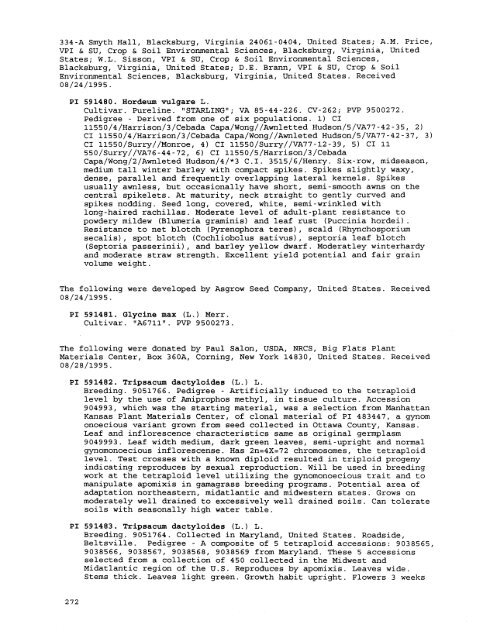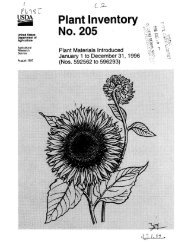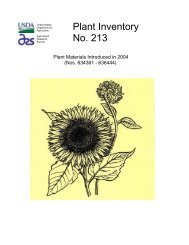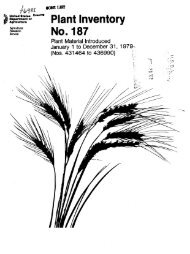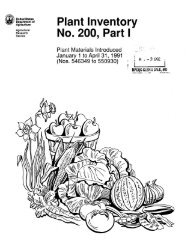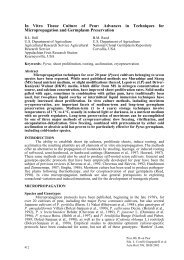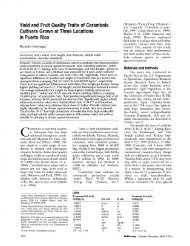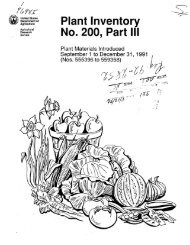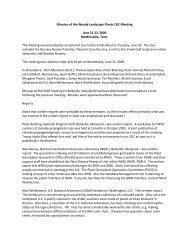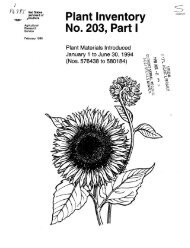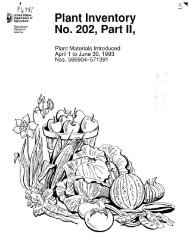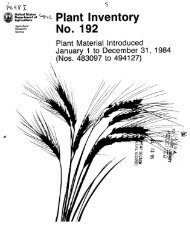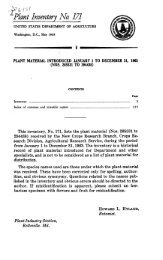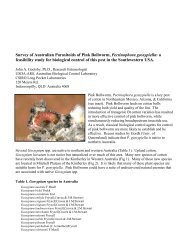Plant Inventory No. 204, Part II - Germplasm Resources Information ...
Plant Inventory No. 204, Part II - Germplasm Resources Information ...
Plant Inventory No. 204, Part II - Germplasm Resources Information ...
Create successful ePaper yourself
Turn your PDF publications into a flip-book with our unique Google optimized e-Paper software.
334-A Smyth Hall, Blacksburg, Virginia 24061-0404, United States; A.M. Price,<br />
VPI & SU, Crop & Soil Environmental Sciences, Blacksburg, Virginia, United<br />
States; W.L. Sisson, VPI & SU, Crop & Soil Environmental Sciences,<br />
Blacksburg, Virginia, United States; D.E. Brann, VPI & SU, Crop & Soil<br />
Environmental Sciences, Blacksburg, Virginia, United States. Received<br />
08/24/1995.<br />
PI 591480. Hordeum vulgare L.<br />
Cultivar. Pureline. "STARLING"; VA 85-44-226. CV-262; PVP 9500272.<br />
Pedigree - Derived from one of six populations. 1) CI<br />
11550/4/Harrison/3/Cebada Capa/Wong//Awnletted Hudson/5/VA77-42-35, 2)<br />
CI 11550/4/Harrison/3/Cebada Capa/Wong//Awnleted Hudson/5/VA77-42-37, 3)<br />
CI 11550/Surry//Monroe, 4) CI 11550/Surry//VA77-12-39, 5) CI 11<br />
550/Surry//VA76-44-72, 6) CI 11550/5/Harrison/3/Cebada<br />
Capa/Wong/2/Awnleted Hudson/4/*3 C.I. 3515/6/Henry. Six-row, midseason,<br />
medium tall winter barley with compact spikes. Spikes slightly waxy,<br />
dense, parallel and frequently overlapping lateral kernels. Spikes<br />
usually awnless, but occasionally have short, semi-smooth awns on the<br />
central spikelets. At maturity, neck straight to gently curved and<br />
spikes nodding. Seed long, covered, white, semi-wrinkled with<br />
long-haired rachillas. Moderate level of adult-plant resistance to<br />
powdery mildew (Blumeria graminis) and leaf rust (Puccinia hordei).<br />
Resistance to net blotch (Pyrenophora teres), scald (Rhynchosporium<br />
secalis), spot blotch (Cochliobolus sativus), septoria leaf blotch<br />
(Septoria passerinii), and barley yellow dwarf. Moderatley winterhardy<br />
and moderate straw strength. Excellent yield potential and fair grain<br />
volume weight.<br />
The following were developed by Asgrow Seed Company, United States. Received<br />
08/24/1995.<br />
PI 591481. Glycine max (L.) Merr.<br />
Cultivar. "A6711". PVP 9500273.<br />
The following were donated by Paul Salon, USDA, NRCS, Big Flats <strong>Plant</strong><br />
Materials Center, Box 360A, Corning, New York 14830, United States. Received<br />
08/28/1995.<br />
PI 591482. Tripsacum dactyloides (L.) L.<br />
Breeding. 9051766. Pedigree - Artificially induced to the tetraploid<br />
level by the use of Amiprophos methyl, in tissue culture. Accession<br />
904993, which was the starting material, was a selection from Manhattan<br />
Kansas <strong>Plant</strong> Materials Center, of clonal material of PI 483447, a gynom<br />
onoecious variant grown from seed collected in Ottawa County, Kansas.<br />
Leaf and inflorescence characteristics same as original germplasm<br />
9049993. Leaf width medium, dark green leaves, semi-upright and normal<br />
gynomonoecious inflorescense. Has 2n=4X=72 chromosomes, the tetraploid<br />
level. Test crosses with a known diploid resulted in triploid progeny<br />
indicating reproduces by sexual reproduction. Will be used in breeding<br />
work at the tetraploid level utilizing the gynomonoecious trait and to<br />
manipulate apomixis in gamagrass breeding programs. Potential area of<br />
adaptation northeastern, midatlantic and midwestern states. Grows on<br />
moderately well drained to excessively well drained soils. Can tolerate<br />
soils with seasonally high water table.<br />
PI 591483. Tripsacum dactyloides (L.) L.<br />
Breeding. 9051764. Collected in Maryland, United States. Roadside,<br />
Beltsville. Pedigree - A composite of 5 tetraploid accessions: 9038565,<br />
9038566, 9038567, 9038568, 9038569 from Maryland. These 5 accessions<br />
selected from a collection of 450 collected in the Midwest and<br />
Midatlantic region of the U.S. Reproduces by apomixis. Leaves wide.<br />
Stems thick. Leaves light green. Growth habit upright. Flowers 3 weeks<br />
272


